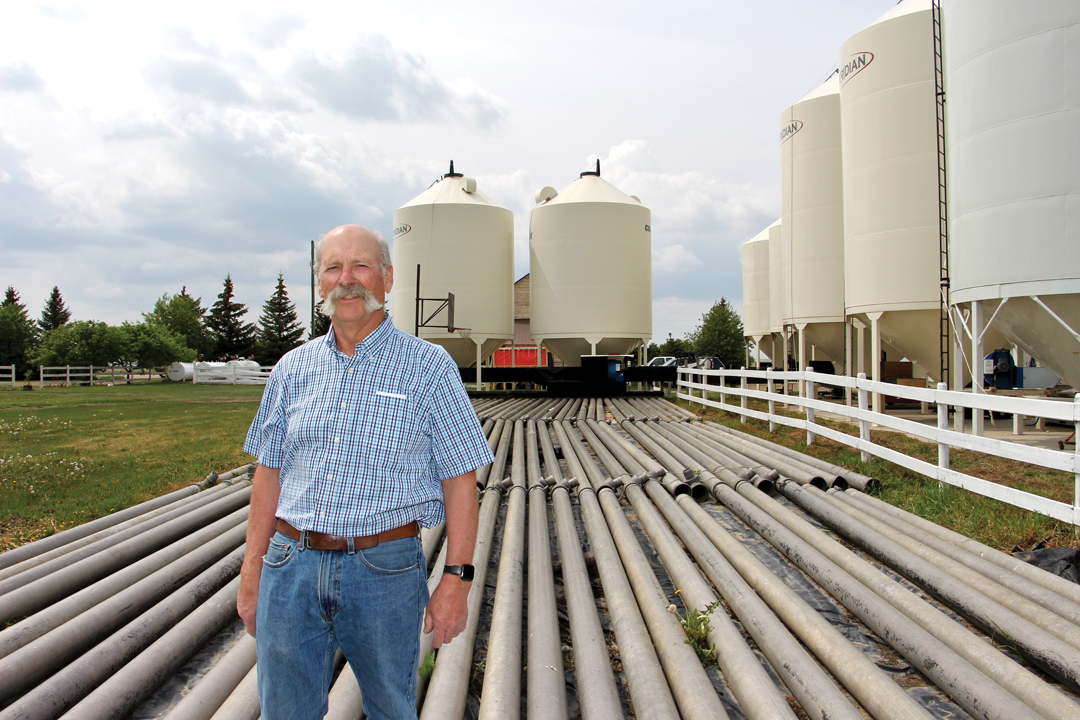THE UPS AND DOWNS OF WET WEATHER
BY IAN DOIG • PHOTO: PIXABAY
Spring across much of the Canadian Prairies brought relief for farmers who had endured multiple years of very dry weather. Through to late July, almost everywhere in Alberta but Peace Country, moisture has been happily adequate. Environment and Climate Change Canada has even reported the month of July 2025 will likely be the fourth or fifth wettest on record for Calgary.
As the saying goes, rain makes grain, but has this bountiful moisture become too much of a good thing? At risk of being a wet blanket, GrainsWest took this watery worry to Alberta Grains agronomy programs specialist Lara de Moissac.
GrainsWest: What is the positive side of the high moisture we’ve enjoyed almost to the end of July 2025?
Lara de Moissac: Rainfall has been adequate in parts of the province that have been deficient for years. Part of the Palliser Triangle has not received significant rainfall in the last six to 10 years. The eastern side of the province—Oyen, Hanna, Drumheller—that corridor has been quite dry for about the last six years. Rain may not have been perfectly timed in the spring, but, back in June, those areas probably got enough for the crop to get going and for yield to have been set. In the last month and a half, surface soil moisture improved in much of the province, meaning adequate supply for crop uptake during that vegetative stage where the crop is getting enough nutrients. It could be spotty, but yield could be set high because of the moisture, and nutrient uptake was probably good because of the moisture.
GW: What would be the ideal weather forecast between now and harvest versus the worst?
LDM: For July, the rains have provided lots of moisture for filling grain kernels. They could become really plump, even if their yield isn’t high. But if it can remain cooler and dry for August and September, hovering around that 25 C mark, that would be great for the rest of the filling stage but also for maturity. Worst-case scenario is way too much heat during August, and we end up with crops that burn up without kernels continuing to plump. Or, they stay the same, and they remain at the stage they’re at now.
The other thing about all this, is the timeliness of the rain in the spring and the summer. Back in spring, some pockets in the south and central regions didn’t get rain. They seeded, and crops started to come up, and then maybe they got a rain in late June or early July. Now, some people may see later tillers come up as a second flush, while the earlier tillers have already headed it out. That creates management questions.
GW: How may ongoing high moisture conditions affect Alberta cereal crops?
LDM: Those crops that set yield around booting stage without good moisture are likely filling nicely but won’t yield that much. Those that set yield with good moisture are likely filling nicely, and yield will also be good. If you didn’t have either, you’re out of luck.
The other thing about prolonged moisture, though, is we’ve heard reports of stripe rust, powdery mildew, and of course, the run-of-the-mill leaf diseases. If wet conditions continue, and farmers couldn’t get any fungicide passes done, there will be some severely disease-affected crops out there.
GW: What actions may farmers be required to take if August remains wet?
LDM: If a farmer is dealing with a lot of second growth tillers, this is the time to assess their crop for the percentage that contains late tillers. Let’s say it’s only one late tiller for every 10 advanced tillers, the value of waiting for those tillers to mature and catch up to the rest of the crop for harvest is low compared to, let’s say, one late tiller for every two advanced tillers.
They must make a judgment call about the percentage of their fields that have late tillers. Then they may have to check on staging of those later tillers. How far along are they, and is it worth waiting for them? Are they potentially going to have some greens when they go to harvest? Of course, that could all change during August. If they have greens, they must consider the target market and where the greens can be sold. If that target market will tolerate greens, they may have to consider cleaning and storage risks. If there’s high enough moisture, will it increase their spoilage and create quality issues? Will they need to clean it before they sell it? They may have to switch the market they sell it into.
GW: How might conditions affect the need for grain drying at harvest?
LDM: It will depend on the percentage of the field that has late tillers. Some areas in central Alberta may have tillers with viable grain. The advanced tillers would have a different maturity staging. If your late tillers are at soft dough and the rest of your crop is mature, perhaps you wait another week or so, but that all depends on that staging. A lot can happen during harvest in terms of the maturity and the dry down.
Going back to that ideal forecast, if it’s sunny and 25 C, that gives you good conditions for kernel dry down. You can have about two per cent grain moisture decrease per day on warm, dry days, and one per cent on overcast days. They can factor that into harvest decision making.
Swathing could also be a valuable strategy if the difference between the early and late tillers is too big to wait, or if using a pre-harvest glyphosate application isn’t an option, on malt barley for example. The label for glyphosate doesn’t account for late tiller management. All it says is grain moisture needs to be less than 30 per cent in the least mature areas of the crop. If you have a high percentage of late tillers, you are waiting for that grain to be less than 30 per cent. You could be in for a bit of a waiting game or you’re looking at running greens through the grain dryer if you have one.
GW: Ideally, would those new tillers increase yield?
LDM: Yes. It could be worth it to wait, especially if you’ve got one late tiller for two advanced tillers.
GW: What are the harvest implications of the low moisture situation in Peace Country? Could August rain help?
LDM: Harvest in the Peace Country could be super straightforward and “easy” in terms of timing decisions, compared to the rest of the province. If it stays dry, they go out and harvest what they can. They won’t have good yields, but hopefully they’ve gotten timely enough rains. It may not be a bumper crop, but maybe it’s the average they’ve experienced in recent years. They will likely harvest a bit early—in late August to early September. Other than keeping the dust down, an August rain won’t help the crop, but it will add to soil moisture.
GW: Can we end this moisture discussion on a positive note?
LDM: The forecast looks favourable for the crop not burning up and drying down at a steady pace. Don’t panic and keep a level head when you’re looking at the forecast. At the very least, get out and have a look at your first-seeded and last-seeded crops to see what you’ve got, and make a plan.
For more information, click here:







Comments